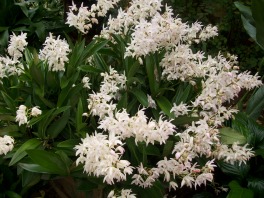Oncidium Orchid Species and Hybrids
Oncidium Orchid Care
There are several hundred oncidium species and most thrive in normal indoor conditions.
Large pseudobulbs rise from a mass of thin white roots.
Their large leaves emerge from the pseudobulbs, and can grow up to 2 ft. Blooms appear in fall.
Flower
Branching flower spikes bears dozens of exotic flowers, usually
 yellow, red,
mahogany, or white, some with wonderful scents.
yellow, red,
mahogany, or white, some with wonderful scents.Bloom time varies, depending on variety, climate, and care.
A full-grown plant can send out six or seven branched sprays of yellow flowers.
The spray of blooms resembles a cloud of delicate butterflies.
Oncidium Orchid Care Tips
Lighting RequirementsBright year-round. If kept outdoors during the summer, keep this orchid out of direct sunlight.
Temperature Requirements
In winter, cool (60° F / 16° C nights and 75° F / 24° C days); in summer, intermediate (60° F / 16° C nights and days in the 75 – 80° F / 24 - 27° C range).
Humidity Requirements
Thirty to sixty percent humidity is ideal for oncidium orchids. This can be provided by placing the orchid pot on a tray of gravel filled with a small amount of water or by placing a humidifier in the room. A greenhouse should also provide sufficient humidity.
Fertilizer
Fertilize every third watering during spring and summer. Feed monthly in fall and winter. Fertilizer should be mixed at ½ the strength – this orchid is prone to fertilizer burn.
Tip: To prevent and remove excess salts from potting soil, thoroughly flush with clear water every month.
Water
During summer, keep potting media slightly moist. From fall through spring, let oncidiums become almost dry between watering.
Soil
Orchid Potting Mix
Propagation
When plants have developed more than six pseudobulbs, divide them into clusters of three bulbs or more and repot. Oncidium orchids only need to be divided every seven to eight years.
Repotting
- Cover a flat work space with butcher paper or newspaper. To loosen the orchid, tap the pot gently or slide a knife between the soil and the pot.
- Tilt the orchid pot sideways and gently remove the plant from the pot and lay it on the work surface.
- Remove as much of the potting mix from the orchid roots as possible.
- Find a section of the orchid roots that have at least three pseudobulbs. Gently pull it away from the main plant. Separate by working your fingers through the root ball. If necessary, use a sharp knife to cut through the smaller roots of the orchid (avoid cutting major roots).
Note: Each division
should have at least three pseudobulb growths.
- The ideal pot is 6 inches in diameter and has a drainage hole in the bottom. To ensure proper drainage, place 1 in/2.5 cm of pebbles, broken pottery pieces, or other drainage material in the bottom of the orchid pot. Fill the pot 1/2 full of orchid compost - usually consists of a mixture of peat moss, bark, sand and other matter.
- Push stakes into the orchid medium as needed to support flower stems. Use plant ties to secure them. The weight of the buds tends to bow or bend the stems, so support is essential in ensuring a good view of the blooms.
- Water oncidium orchids when potting soil is dry halfway down. Saturate the bark fully. During summer, keep potting media slightly moist. From fall through spring, let oncidiums become almost dry between watering.
Longetivity
Oncidium orchids can last many years when propagated by division.
Selection
A unique hybrid is the Wildcat “Bobcat” orchid. Dark burgundy flowers adorn branch spikes.
Uses and Display Tips
A windowsill in a bright, sunny location when not in bloom. As the flowers develop, display oncidiums as a tall floor plant.
Other Types of Orhcids
| Cattleya Orchids - Large Stunning Blooms |
| Cymbidium Orchids - Long-Lasting Flowers |
| Dendrobium Orchid - Arching Displays of Beautiful Flowers |
| Paphiopedilum Orchid - Slipper-Shaped Flowers |
| Phalaenopsis Orchid - Elegant Long-Lasting Flowers |





